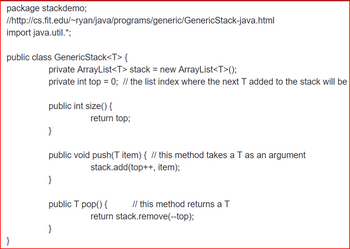
A) Write a generic Java queue class (a plain queue, not a priority queue). Then, call it GenericQueue, because the JDK already has an interface called Queue. This class must be able to create a queue of objects of any reference type. Consider the GenericStack class shown below for some hints. Like the Stack class below, the GenericQueue should use an underlying ArrayList<E>.
Write these methods and any others you find useful:
enqueue() adds an E to the queue
peek() returns a reference to the object that has been in the queue the longest, without removing it from the queue
dequeue() returns the E that has been in the queue the longest, and removes it from the queue
contains(T t) returns true if the queue contains at least one object that is equal to t *in the sense that calling .equals() on the object with t the parameter returns true.* Otherwise contains returns false.
size() and isEmpty() are obvious.

Trending nowThis is a popular solution!
Step by stepSolved in 3 steps with 1 images

- In JAVA please Write a generic AddressBook<E extends Person> class that manages a collection ofPerson objects. The AddressBook class is a generic class limited to person objects. Forexample, once you instantiate an AdressBook of Student objects, you cannot add anyother type of person objects into that instance of address book.The AddressBook should have methods to add, delete, or search for a Person objects inthe address book.• The add method should add a person object to the address book. Make sure thatthe add method does not add duplicate person objects to the address book.• The delete method should remove the specified person object from the addressbook.• The search method that searches the address book for a specified person andreturns the list of persons matching the specified criteria. The search can be doneeither by first name, last name, or person id.Write an AddressBookTester class to test your class.arrow_forwardSuppose you are trapped on a desert island with nothing but a priority queue, and you need to implement a stack. Complete the following class that stores pairs (count, element) where the count is incremented with each insertion. Recall that make_pair(count, element) yields a pair object, and that p.second yields the second component of a pair p. The pair class defines an operator< that compares pairs by their first component, and uses the second component only to break ties.Code: #include <iostream>#include <queue>#include <string>#include <utility> using namespace std; class Stack{public: Stack(); string top(); void pop(); void push(string element);private: int count; priority_queue<pair<int, string>> pqueue;}; Stack::Stack(){ /* Your code goes here */} string Stack::top(){ /* Your code goes here */} void Stack::pop(){ /* Your code goes here */} void Stack::push(string element){ /* Your code goes here */} int main(){ Stack…arrow_forwardJava Code: Create a Parser class. Much like the Lexer, it has a constructor that accepts a LinkedList of Token and creates a TokenManager that is a private member. The next thing that we will build is a helper method – boolean AcceptSeperators(). One thing that is always tricky in parsing languages is that people can put empty lines anywhere they want in their code. Since the parser expects specific tokens in specific places, it happens frequently that we want to say, “there HAS to be a “;” or a new line, but there can be more than one”. That’s what this function does – it accepts any number of separators (newline or semi-colon) and returns true if it finds at least one. Create a Parse method that returns a ProgramNode. While there are more tokens in the TokenManager, it should loop calling two other methods – ParseFunction() and ParseAction(). If neither one is true, it should throw an exception. bool ParseFunction(ProgramNode) bool ParseAction(ProgramNode) -Creates ProgramNode,…arrow_forward
- Java Solution with explanation in detailed please!arrow_forwardYou will create two programs. The first one will use the data structure Stack and the other program will use the data structure Queue. Keep in mind that you should already know from your video and free textbook that Java uses a LinkedList integration for Queue. Stack Program Create a deck of cards using an array (Array size 15). Each card is an object. So you will have to create a Card class that has a value (1 - 10, Jack, Queen, King, Ace) and suit (clubs, diamonds, heart, spade). You will create a stack and randomly pick a card from the deck to put be pushed onto the stack. You will repeat this 5 times. Then you will take cards off the top of the stack (pop) and reveal the values of the cards in the output. As a challenge, you may have the user guess the value and suit of the card at the bottom of the stack. Queue Program There is a new concert coming to town. This concert is popular and has a long line. The line uses the data structure Queue. The people in the line are objects…arrow_forward
 Database System ConceptsComputer ScienceISBN:9780078022159Author:Abraham Silberschatz Professor, Henry F. Korth, S. SudarshanPublisher:McGraw-Hill Education
Database System ConceptsComputer ScienceISBN:9780078022159Author:Abraham Silberschatz Professor, Henry F. Korth, S. SudarshanPublisher:McGraw-Hill Education Starting Out with Python (4th Edition)Computer ScienceISBN:9780134444321Author:Tony GaddisPublisher:PEARSON
Starting Out with Python (4th Edition)Computer ScienceISBN:9780134444321Author:Tony GaddisPublisher:PEARSON Digital Fundamentals (11th Edition)Computer ScienceISBN:9780132737968Author:Thomas L. FloydPublisher:PEARSON
Digital Fundamentals (11th Edition)Computer ScienceISBN:9780132737968Author:Thomas L. FloydPublisher:PEARSON C How to Program (8th Edition)Computer ScienceISBN:9780133976892Author:Paul J. Deitel, Harvey DeitelPublisher:PEARSON
C How to Program (8th Edition)Computer ScienceISBN:9780133976892Author:Paul J. Deitel, Harvey DeitelPublisher:PEARSON Database Systems: Design, Implementation, & Manag...Computer ScienceISBN:9781337627900Author:Carlos Coronel, Steven MorrisPublisher:Cengage Learning
Database Systems: Design, Implementation, & Manag...Computer ScienceISBN:9781337627900Author:Carlos Coronel, Steven MorrisPublisher:Cengage Learning Programmable Logic ControllersComputer ScienceISBN:9780073373843Author:Frank D. PetruzellaPublisher:McGraw-Hill Education
Programmable Logic ControllersComputer ScienceISBN:9780073373843Author:Frank D. PetruzellaPublisher:McGraw-Hill Education





